Pink whipray
(Pateobatis fai)

Image source: Jo's Animal Database
Classification
General data
The pink whipray (Pateobatis fai) is a species of stingray in the family Dasyatidae, with a wide but ill-defined distribution in the tropical Indo-Pacific from southern Africa to Polynesia.
It is a bottom dweller that generally inhabits shallow water under 70 m (230 ft) deep, in sandy areas associated with coral reefs. Individuals exhibit a high degree of fidelity to particular locations.
The pink whipray has a diamond-shaped pectoral fin disc wider than long, with a broad-angled snout and a very long, whip-like tail without fin folds. It has only a few small thorns on its back and is uniform brownish to grayish pink in color, becoming much darker past the tail sting.
The pink whipray can be identified by its uniform grayish dorsal coloration, which darkens past the sting.
The pectoral fin disc of the pink whipray is diamond-shaped and thick at the center, measuring about 1.1–1.2 times wider than long. The outer corners of the disc are angular. The snout forms a very obtuse angle, with the tip barely protruding. The small, widely spaced eyes are followed by larger spiracles. There is a short and broad curtain of skin with a finely fringed posterior margin between the long, thin nostrils. The mouth is fairly small and surrounded by prominent furrows; the lower jaw has a small indentation in the middle. There are two large central and two tiny lateral papillae on the floor of the mouth. The teeth are small and arranged into pavement-like surfaces. Five pairs of gill slits are located beneath the disc. The pelvic fins are small and narrow.
The tail is extremely long and thin, measuring at least twice the disc length when intact. It lacks fin folds and usually bears a single serrated stinging spine. Adults have small, rounded dermal denticles covering the central dorsal surface of the disc, beginning in front of the eyes and extending to cover the entire tail; there are also small, sharp thorns on the midline, which become densest at the base of the tail. Juveniles are either smooth-skinned or have a sparser covering of flat, heart-shaped denticles. This species is uniform grayish to brownish pink above, becoming dark gray to black on the tail past the sting, and uniformly light below.
It grows to at least 1.8 m (5.9 ft) across and over 5 m (16 ft) long. Its maximum weight on record is 19 kg (42 lb).
The exact range of the pink whipray is unclear due to confusion with the H. jenkinsii. It is believed to be common throughout the tropical waters of the Indo-Pacific, probably occurring all around Indian Ocean periphery from South Africa to northern Australia, from the year 2014 appears in the Red Sea. Its range extends to the Pacific Ocean, northward to the Philippines, the Ryukyu Islands, and Iriomote, and eastward to various islands including Micronesia, the Marquesas Islands, and Samoa.












